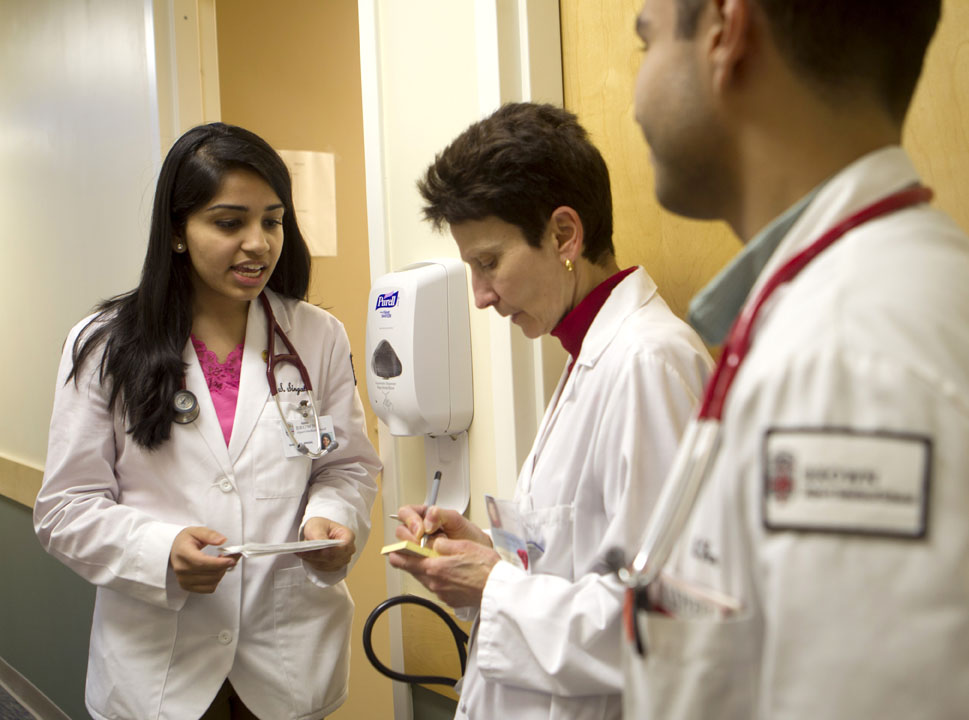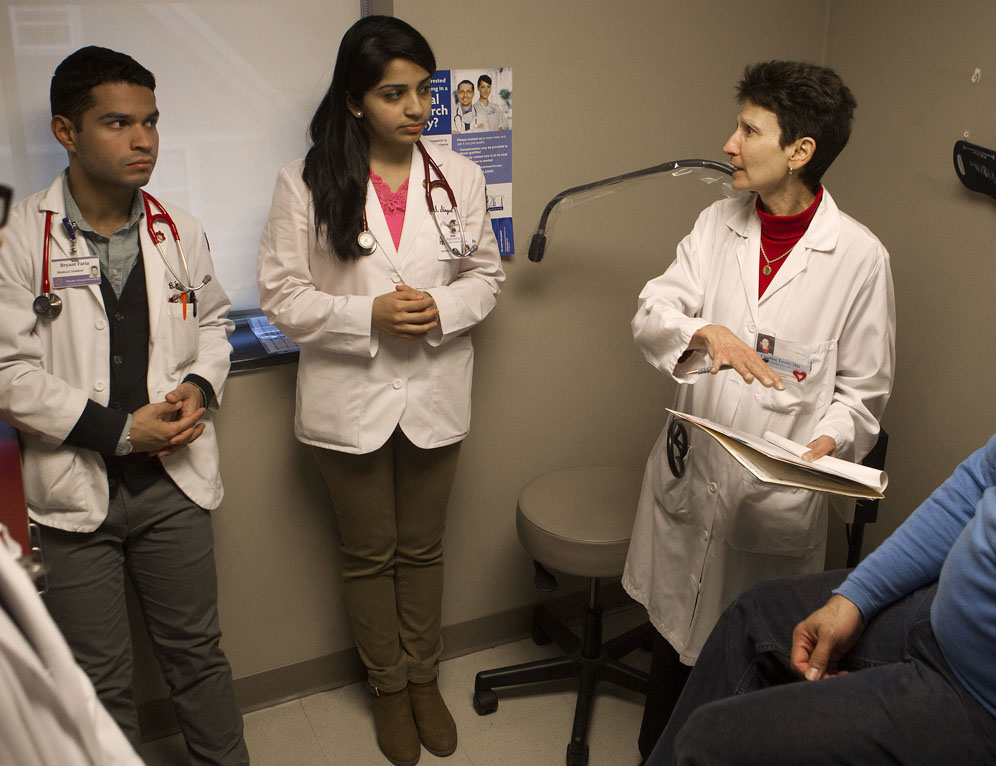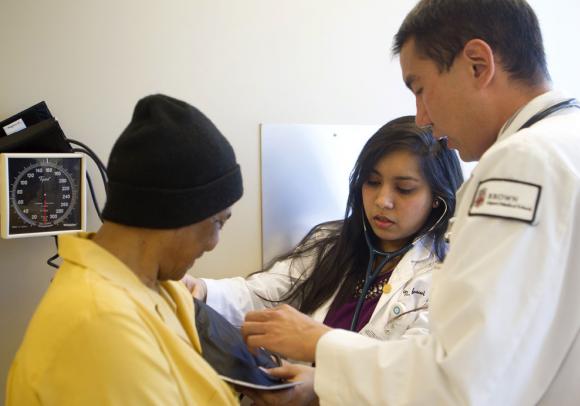PROVIDENCE, R.I. [Brown University] — The 10 first-year Alpert Medical School students of the Brown Student Community Clinic (BSCC) saw only a tiny fraction of the 2,059 uninsured patients served by the Rhode Island Free Clinic (RIFC) on Broad Street in 2013. But in the exam rooms, where the patients receive uncommonly close attention and the future doctors gain invaluable experience and inspiration, it's not about aggregate numbers. It’s about people. (See sidebar 20 groups for service and advocacy.)
On an unseasonably chilly Monday evening in late March, a 71-year-old Creole-speaking Hatian woman, call her “Rosette,” comes to the BSCC with her daughter for a follow-up visit. She reports no major problems, but her care team, including first-year student Norin Ansari, is watching issues including the possibility of diabetes, high blood pressure, milky clouding of her vision and her response to a new regimen of cholesterol medicine.
Ansari takes Rosette’s basic measurements, such as height, weight, and blood pressure. As fellow first-year student Divya Dethier translates, Ansari asks how Rosette feels and whether she takes her medicine regularly. Fourth-year student and BSCC veteran David Kim has returned to assist Ansari with the exam and interview, guiding her on finer points of medicine. They talk with Rosette about her diet and exercise habits. They ask about whether she ever smoked or drank. They ask about dizziness and headaches.
They are thorough and wide-ranging. Rosette and her daughter are happy to field all the questions and participate in the exam. Patients can decline to be seen by the BSCC, said RIFC’s CEO Marie Ghazal, but they don’t. The clinic’s volunteer physicians oversee all the student-led care, so there is no diminution in quality.

Instead, the students’ mission of caring for patients and learning primary care skills is entirely consistent with the RIFC’s mission, Ghazal said. That’s why the RIFC agreed to host and support the student clinic when it launched in 2011.
“We know there is a shortage of primary care docs,” Ghazal said. “We want more young doctors to go into primary care and to work with this population. When you talk to these students, you hear them say this is the best experience they’ve had. People who come to Brown say they are interested in coming here because of the opportunities at the RIFC.”
Real patients
The appeal is clear to BSCC student Geoffrey McCrossan.
“I’m in medical school because I want to take care of patients, regardless of what specialty I go into,” he said. “This gives me an opportunity to practice what I’m learning in the doctoring portion of our curriculum but also to give context to the knowledge I’m learning in the classroom.
“That big stack of books has a whole set of conditions in it that can seem extremely abstract. But then you come here into the clinic and you see patients and see the human component of the disease. You can catch something in a chart, talk to your attending [physician] about it. It’s a sort of more organic classroom and it satisfies that fundamental urge we all have while we’re here in medical school to serve.”
After 40 minutes of conversation and examination, Ansari, Kim, and Dethier step out of the exam room. Kim helps Ansari rehearse how she’ll present Rosette’s case to the attending physician, Dr. Sybil Cineas, who has volunteered. When she arrives, Ansari and Kim describe what they’ve found. Together they return to Rosette and her daughter to discuss the care they’ll deliver.
Elsewhere at the BSCC the team of first-year student Sanchita Singal, fourth-year student Bryant Faria and RIFC medical director Dr. Caroline Troise are doing the same for “Julio,” (also not his real name). The 59-year-old unemployed house painter from Colombia has arrived for a wellness checkup. It’s clear to Singal that not all is well.
Singal is sure to tell Troise about what she and Faria have learned in their initial exam and interview. For months Julio has suffered from excruciating joint pain that he’s tried to control by regularly taking ibuprofen pills every few hours each day. He’s also experienced headaches so severe that he once fainted and was rushed to Rhode Island Hospital. He’s been feeling financially stressed but has social and moral support from family who live in the area. His blood pressure seems high, and he’s also on a statin to control his elevated cholesterol.

Troise leads the students in forming a plan for Julio. When they return to him, she asks him about whether the pain coincides with his medicines – statins sometimes cause joint pain and extensive use of painkillers can sometimes cause headaches – but she also orders several blood tests and X-rays of his legs. He’ll come back in a month and they’ll continue working to help him get well.
‘This is so uplifting’
After Julio’s visit is over, Troise’s thoughts turn to the students. At the clinic, she says, they get to practice primary care as it’s supposed to be. Rather than filling out forms and entering data, the students can spend more time with their patients.
“This is so uplifting for me to have young people so interested in primary care,” said Troise, who is the RIFC’s volunteer medical director. “Before it was you and the patient. Now it is you and the patient and the medical insurer ... and the whole bureaucracy of everyone taking care of your patient but the doctor.
“One of the best things about being a doctor is not writing a prescription, it’s the bond you have with that person,” Troise tells the students. “There is so much healing that goes on just by speaking and listening.”
The students’ attentiveness, she said, sometimes evokes important details from patients that more experienced but expedient doctors will miss.
Last year BSCC students learned in their interview with a diabetes patient that she was not only severely depressed but also expressing suicidal thoughts. That revelation allowed Troise to get her seen by a mental health specialist and admitted to Rhode Island Hospital’s psychiatry service.
The students who’ve chosen to spend their precious free time here are eager to achieve such degrees of patient care. They are excited by the chance to get a head start on clinical practice.
“Brown has a philosophy of empowering the students both in the classroom and in the clinical sphere, and the BSCC clinic stands as a representation of that,” said Vinay Rao. “We have so many opportunities where we can actually get involved in patient care very early on in our medical education. We’re first-years yet we are already seeing patients, which is pretty incredible. Our entire goal is to be the best clinicians we possibly can be.”
They’d like to expand from seeing four patients a month to six. That will require finding additional financial support, however. That’s the nature of free clinics.
But at any level of contribution, they are doing well by doing good.
“It's more about the quality of the patient experience and the value of the student experience,” Ghazal said. “We're not a business to churn people in and out, but a model of care to really help people to change their lives — and we know the students are here to do that.”

